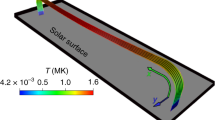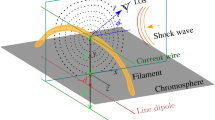Abstract
The formation of fibrils in low-lying loops is investigated by performing one-dimensional nonlinear hydrodynamic calculations. The loops have the height of 3000–5000 km and have an atmosphere extending from the photosphere to the corona. A shock wave is generated from a pressure pulse in the photosphere and it ejects the chromosphere-corona transition region along the loop, expanding the underlying chromosphere into the corona. This expanding chromospheric material in a loop is regarded as a fibril. The shock propagates in the corona and collides with another transition region where a reflected shock and a penetrating shock are generated. The effect of the reflected shock on the motion of the fibril is weak. The fibril shows a nearly ballistic motion as observations suggest, if it does not extend beyond the summit of the loop. The corona in the loop is compressed nearly adiabatically by the fibril, and the enhanced coronal pressure leads the fibril finally to a retracting motion even if the fibril goes beyond the summit of the loop.
Similar content being viewed by others
References
Athay, R. G.: 1976, The Solar Chromosphere and Corona: Quiet Sun, D. Reidel Publ. Co., Dordrecht, Holland.
Bird, G. A.: 1964, Astrophys. J. 139, 675.
Boris, J. P. and Book, D. L.: 1973, J. Comp. Phys. 11, 38.
Foukal, P.: 1971a, Solar Phys. 19, 59.
Foukal, P.: 1971b, Solar Phys. 20, 298.
Gabriel, A. H.: 1976, Phil. Trans. Roy. Soc. London A281, 339.
Gingerich, O., Noyes, R. W., Kalkofen, W., and Cuny, Y.: 1971, Solar Phys. 18, 347.
Giovanelli, R. G.: 1978, Solar Phys. 59, 293.
Hollweg, J. V.: 1982, Astrophys. J. 257, 345.
Hollweg, J. V., Jackson, S., and Galloway, D.: 1982, Solar Phys. 75, 99.
Landau, L. D. and Lifshitz, E. M.: 1959, Fluid Mechanics, Pergamon Press, Oxford.
Marsh, K. A.: 1976, Solar Phys. 50, 37.
Nakagawa, Y. and Steinolfson, R. S.: 1976, Astrophys. J. 207, 296.
Shibata, K.: 1983, Publ. Astron. Soc. Japan 35, 263.
Shibata, K., Nishikawa, T., Kitai, R., and Suematsu, Y.: 1982, Solar Phys. 77, 121.
Shibata, K. and Suematsu, Y.: 1982, Solar Phys 78, 333.
Suematsu, Y., Shibata, K., Nishikawa, T., and Kitai, R.: 1982, Solar Phys. 75, 99 (Paper I).
Stein, R. F. and Leibacher, J.: 1974, Ann. Rev. Astron. Astrophys. 12, 407.
Stenflo, J. O.: 1976, in V. Bumba and J. Kleczek (eds.), ‘Basic Mechanisms of Solar Activity’, IAU Symp. 71, 69.
Author information
Authors and Affiliations
Additional information
Contributions from the Kwasan and Hida Observatories, University of Kyoto, No. 261.
Rights and permissions
About this article
Cite this article
Suematsu, Y. Mass motions due to shock propagations along low-lying loops in the solar atmosphere. Sol Phys 98, 67–90 (1985). https://doi.org/10.1007/BF00177200
Received:
Revised:
Issue Date:
DOI: https://doi.org/10.1007/BF00177200




